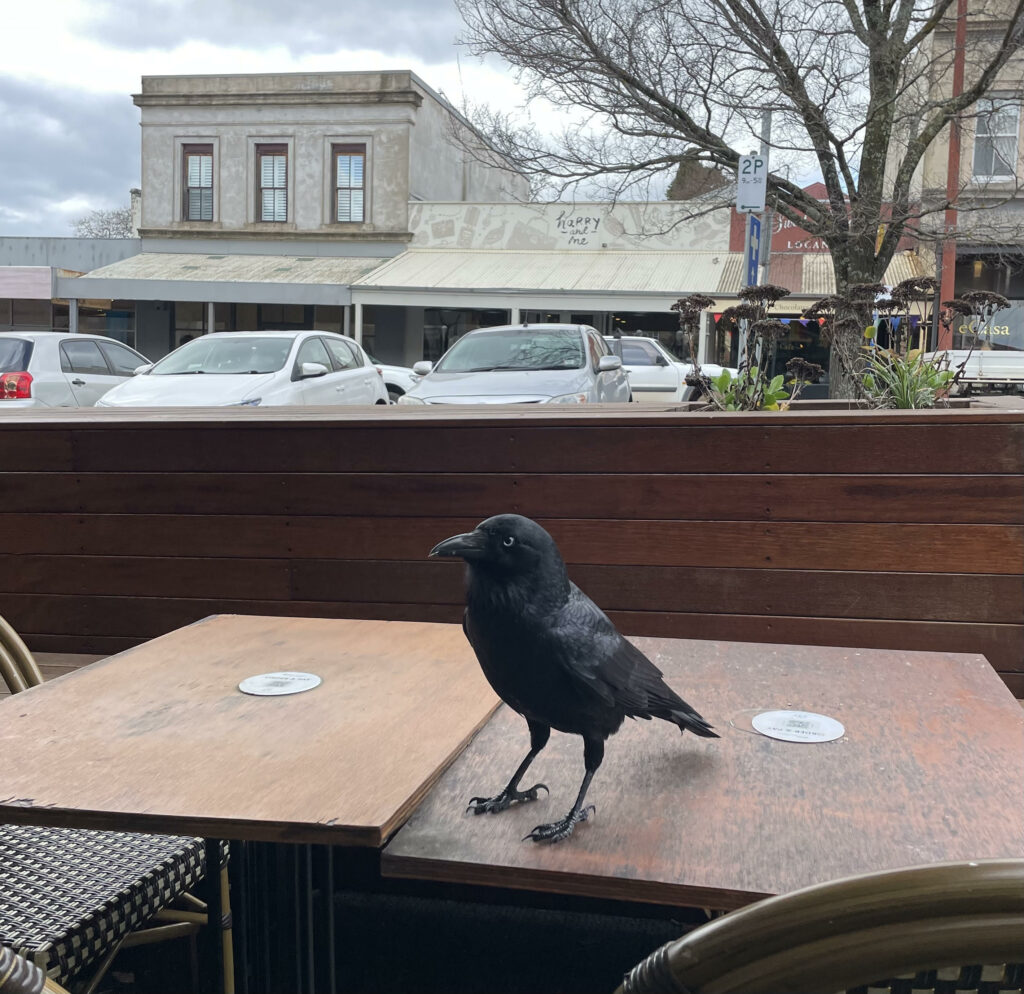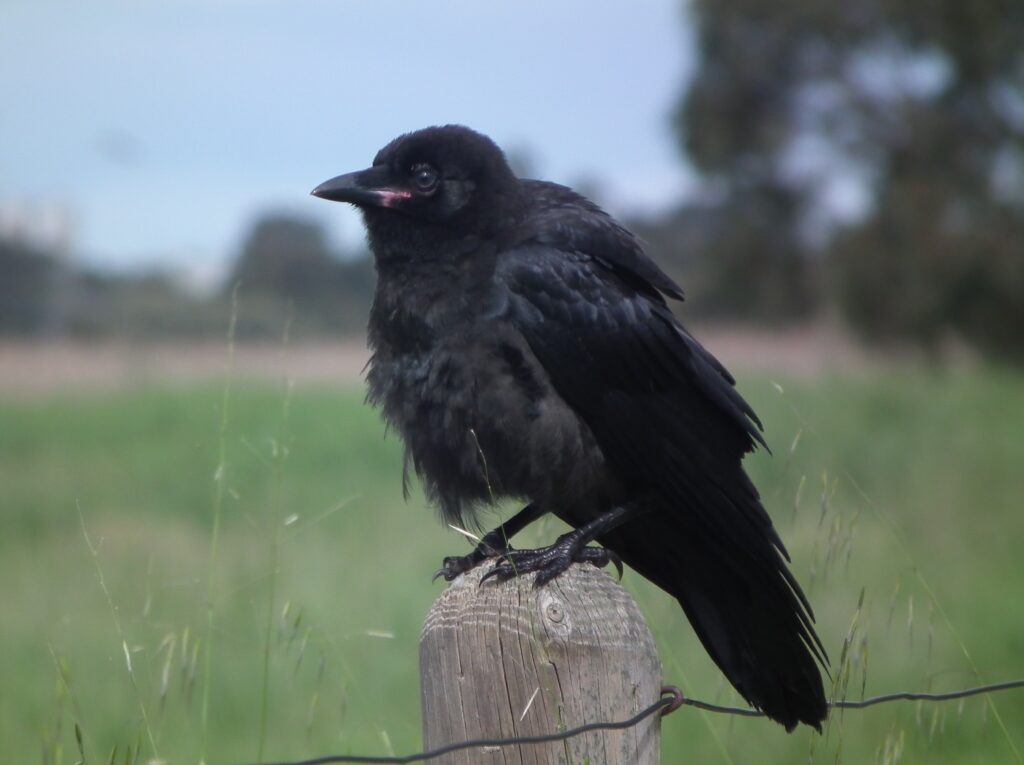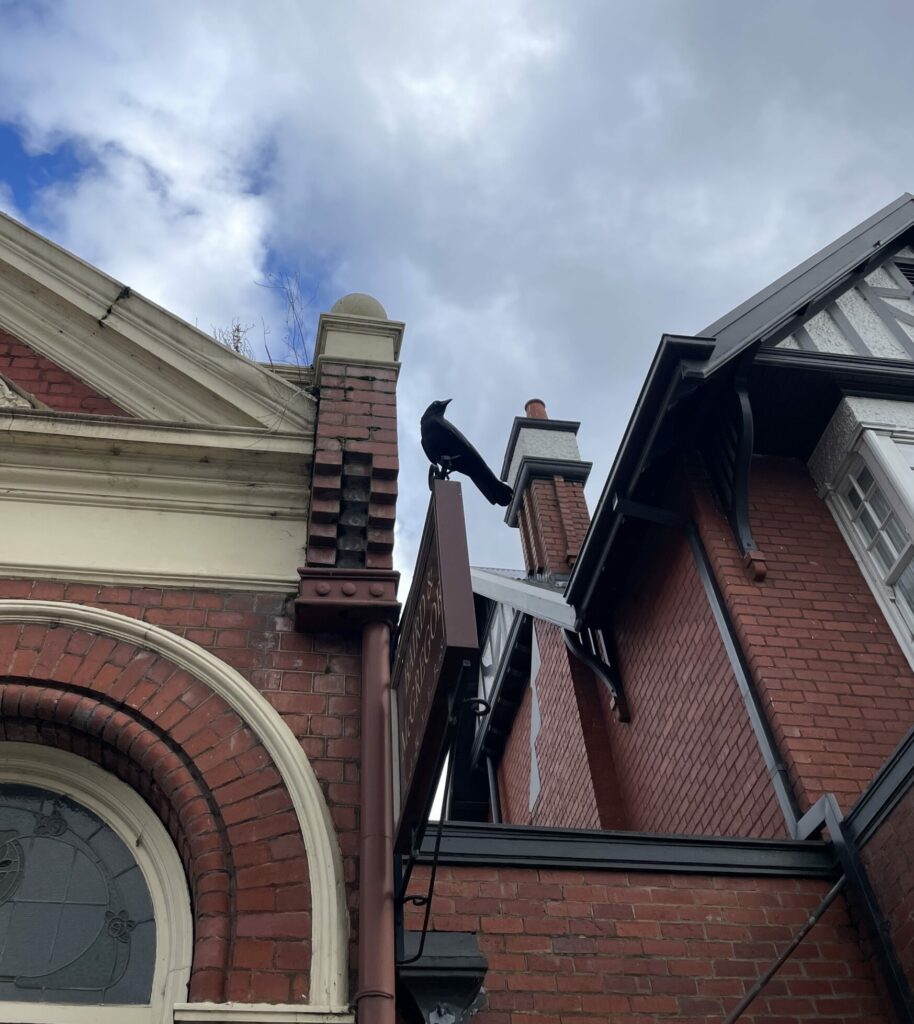
This raven strutted over boldly to check me out – possibly looking at the vegetable pastie I had in my hand as I was taking the photo!
Have you noticed Daylesford’s resident ravens? These large black glossy birds may be seen perched on various shop signs calling loudly or strutting up and down Vincent Street searching for dropped food. They are Little Ravens – a funny name as they are not little at all, in fact they only one centimetre shorter in length to the ‘larger’ Australian Raven- our other local species.
Why are they ravens and not crows? They are both in the Corvidae family, and often called corvids – and all five species of ravens and crows in Australia are black birds with white irises. The only way to tell ravens and crows apart is by somehow blowing on their feathers or examining a dead bird – the base of the feathers is brown in ravens and white in crows.
Raven and crow identification can be very tricky! There are subtle visual differences in the length of the feathers beneath the throat (the hackles), the size of the bill and relative roundness of the head – but the easiest cues are location, behaviour and calls.
Sean Dooley and the team at BirdLife Australia created this helpful video which describes the various corvids to be found in capital cities around Australia. This makes ID very easy as the black bird you are seeing MUST be that particular species eg Little Raven in Melbourne, Australian Raven in Sydney. In some areas eg north coast of NSW you get all five species!
Behaviour is also helpful. The two corvids we have locally have different diets and behaviour. Little Ravens are opportunistic feeders – especially when a particular food is abundant eg locust and mice plagues. When you see a large flock of corvids spread out over a paddock digging for insects – they are Little Ravens. Similarly if you come across a large flock of ravens amassed in the tree canopy in the forest the birds may be feasting upon a stick insect population burst. Australian Ravens are much more solitary, and they prefer meat over insects – they are the birds most likely seen at our many unfortunate road-killed kangaroo carcasses. I am pretty sure Little Ravens will also scavenge at carcasses.
Our local species then perform two very important roles – keeping insects such as beetle grubs and locusts down in the paddocks, and acting as clean-up sanitation agents to recycle the road kill.
The calls of the two birds are different – the Little Raven is a ‘short, rapid, medium-toned guttural ark- aark -aaark – usually ending abruptly’. The Australian Raven utters that classic Aussie sound – ‘a powerful, slow, drawn-out, high-pitched wail, aih-aaah-aaaaaaah with the last wail protracted and dropping in pitch and intensity’.
Another tip – just watch them call! Little Ravens will raise and shuffle their wings as they call, Australian Ravens do not do this. Australian Ravens have longer throat feathers which fluff out when they call but this is not as obvious as the Little Raven’s wing shuffle.
Ravens are already collecting nesting material so breeding season has well and truly begun. Established pairs form breeding territories that last for at least three months while the young are raised. I have seen young ravens around town in spring – so I wonder if we have a few breeding pairs? Very young or juvenile ravens have blue eyes and a pinkish gape at the base of their bill, while immature ravens have brown coloured irises.

Juvenile Little Raven by Wayne Butterworth (Via Wikimedia Commons)
I really enjoy watching the ravens calling loudly from street signs and rubbish bins on Vincent Street– the acoustics are incredible as their calls bounce from footpath to shop and they are not fussed at all by humans. I think they give our town a lively and interesting gothic air!

This raven was keeping a close eye at three other ravens on Vincent Street, Daylesford.
Corvids are renowned for their intelligence – this 16 minute video gives a great overview of some of ways corvids are super smart – with the tool using skills including tool assembly, delayed gratification and planning for the future! It also describes how different avian brains are to mammal brains. And a cool example of wolf and raven friendship https://www.youtube.com/watch?v=7aWL2iEb6y4
And this article is a bit of a laugh as well –
Bird call descriptions from The Australian Bird Guide – Menkhorst et al.
This article was originally published in the Wombat Post https://thewombatpost.com.au/2023/07/14/22588/
Love Ravens.They are very smart birds.
They figure in my recent Children’s book,” Birds in My Tree: The Magic of Birds and the Joy of Singing ”
‘…shiny black raven’s as proud as can be ,